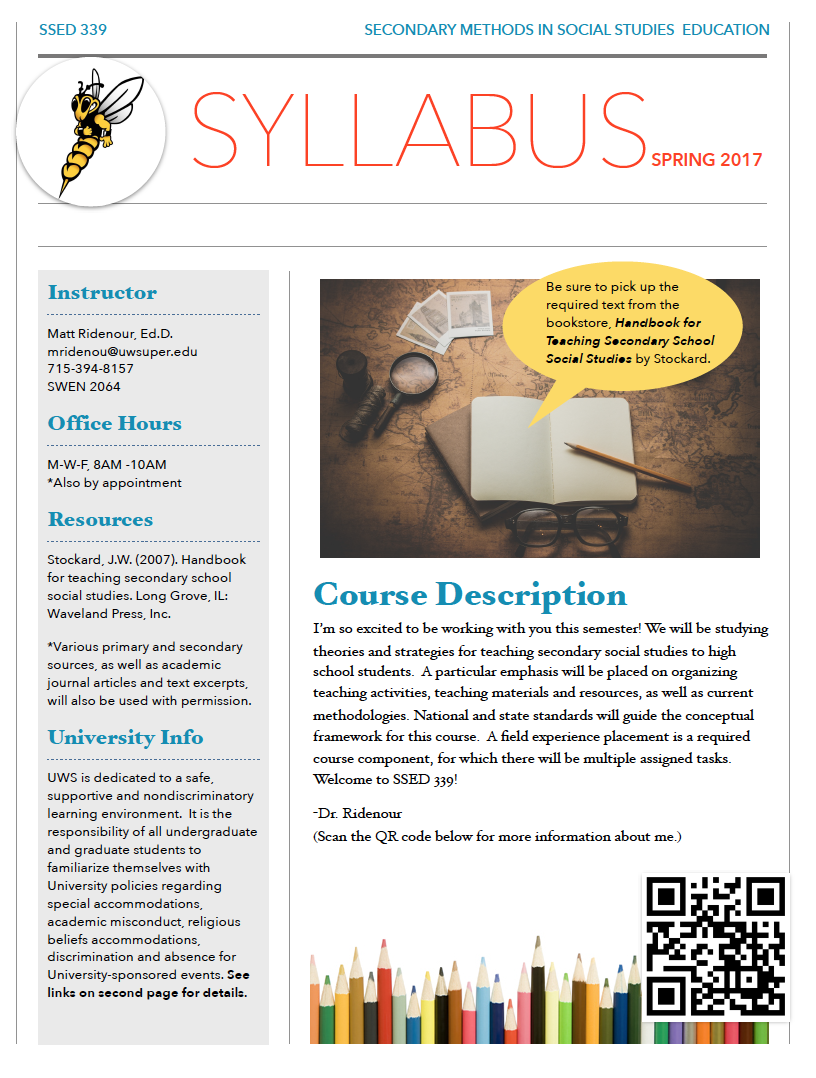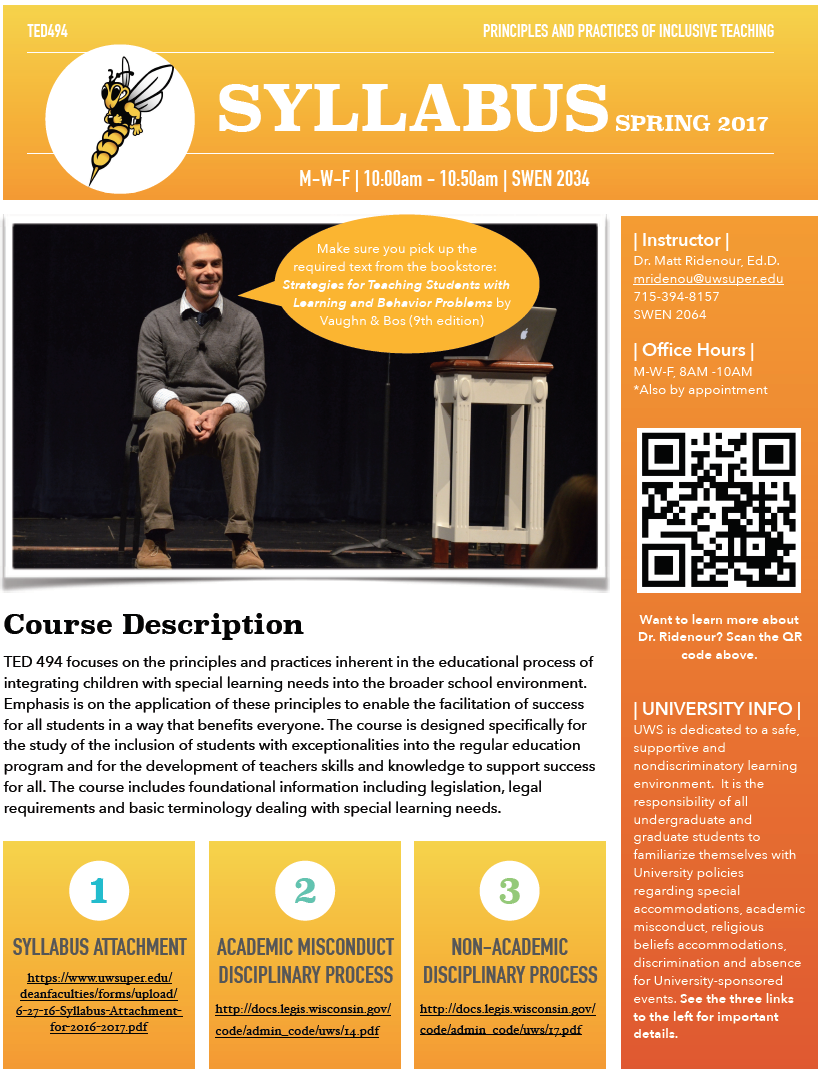TEACHING & ADVISING: NARRATIVE & SUPPORTING MATERIALS (50%)
Teaching continues to be a the center of my work - all other facets of the professorate are born from, and subordinate to, my classroom practice. The narrative and supporting materials provided below outline my commitment to ongoing development of courses for the purpose of improving the student experience. Beyond that, it is my hope that this portion of the portfolio serves as evidence of my ongoing exploration of what it means to teach and advise in a way that transcends the daily work to create more space for influence and the use of my experience and skills.
Spring/Summer 2017 Course Syllabi
In the spring of 2017, I taught several new courses (TED 494 and SSED 339) in addition to SSED 331 (which I had taught in the fall of 2016). I also taught TED 494 and SSED 331 in the summer of 2017. The syllabi for all courses can be viewed at right (click on the images to read the syllabus of your choosing). Please note the syllabi for online and summer sections are the same as the syllabi for the on-campus sections and spring sections, and they are, therefore, not duplicated. Based on reflection and student feedback, several changes were made to the syllabi after my first semester. These changes included the addition of greater details regarding the course schedule and pacing of content (details which I noted as desired areas of improvement in my first year portfolio). The outcome of these changes were positive - students seemed to have a stronger sense of course rhythms, were more likely to turn assignments in on-time, and had generally fewer questions about the work that was expected of them.
Reflection on Course Evaluations
From the very beginning of my career at UWS, I have spent a significant amount of time reflecting on what it means to teach well. No matter the day or the time, no matter the course or the students, no matter the context or the content, it seems that I keep coming back to these words from Parker Palmer:
"Unlike many professions, teaching is always done at the dangerous intersection of personal and public life. As we try to connect ourselves and our subjects with our students, we make ourselves, as well as our subjects, vulnerable to indifference, judgment and ridicule." (Palmer, 1998, p.15)
While it may be counter-intuitive, I believe that this vulnerability - to indifference, to judgment, to ridicule - is the risk required for great teaching. Some call it "authenticity" while others describe it as "putting yourself out there." Either was, doing so as a teacher has a great upside, but also a dangerous downside (as Palmer notes). And this authenticity is the most critical component of my educational philosophy. It's incredibly scary, and always has been. But when I get back evaluations (click image to the right), all those vulnerable moments seem so worth it.
In examining the course evaluations at right, I see evidence that my authenticity as a teacher is valued by students - enthusiasm and passion (which come up often in the student comments) are born from the fact that I am daily expressing from my authentic self. Students also commented positively on the organization of my courses, the variety of methods used, and the frequent opportunities provided to dive deeply into the course material.
Examination of critical and constructive feedback from students yielded a few noteworthy possibilities for change. A few students discussed the amount of group work in a particular course (TED 494); other students mentioned the timing of a particular assignment in that same course. This feedback is incorporated into my teaching goals, provided below.
While not present in the evaluations themselves, formative assessment in all my classrooms has yielded an interesting revelation. Most often, constructive feedback from students (on the daily level) centers on their persistent need to be told exactly how something should be done. Otherwise stated, many of our pre-service teachers seem to see teaching as a prescriptive vocation, one wherein the right formula of pedagogy, philosophy, methodology and content will yield the perfect classroom. While I want to be careful to understand the needs of students, this is a certain genre of student feedback to which I am less likely to bend. This is also addressed in my teaching goals below.
Teaching Goals for the Year
In response to my classroom experience and the evaluations above, I have crafted two teaching related goals for this next year:
1. Relative to the evaluations, I will assess the order of content and methods used in my TED 494 course and will be curious to see if similar feedback (regarding the timing of assignments and effective use of group work, specifically) disappears or persists in the course evaluations after changes are made.
2. I have also made it my goal to disavow students (on a daily basis) of the idea that teaching is in any-way prescriptive. That is to say, "best practice" and "prescriptive" are not synonyms. This has significant implications for my assignments and the feedback I give on them. I am curious if this is a program-wide concern or something that is only manifest in my classes? Either way, I think it is a significant and worthy goal, as I desire for ours to be a program that turns out creative and thoughtful teachers who are flexible in their application of what they have learned at UWS.
Advising
I began advising in the fall of 2017, working with a total of ten students. As an advisor, it is my goal to provide personal attention and wise counsel to students, while also cultivating healthy relationships with these soon-to-be alumni/UWS ambassadors. I find advising to be truly enjoyable, as it affords me the unique opportunity to develop meaningful relationships with students in a non-classroom setting.



